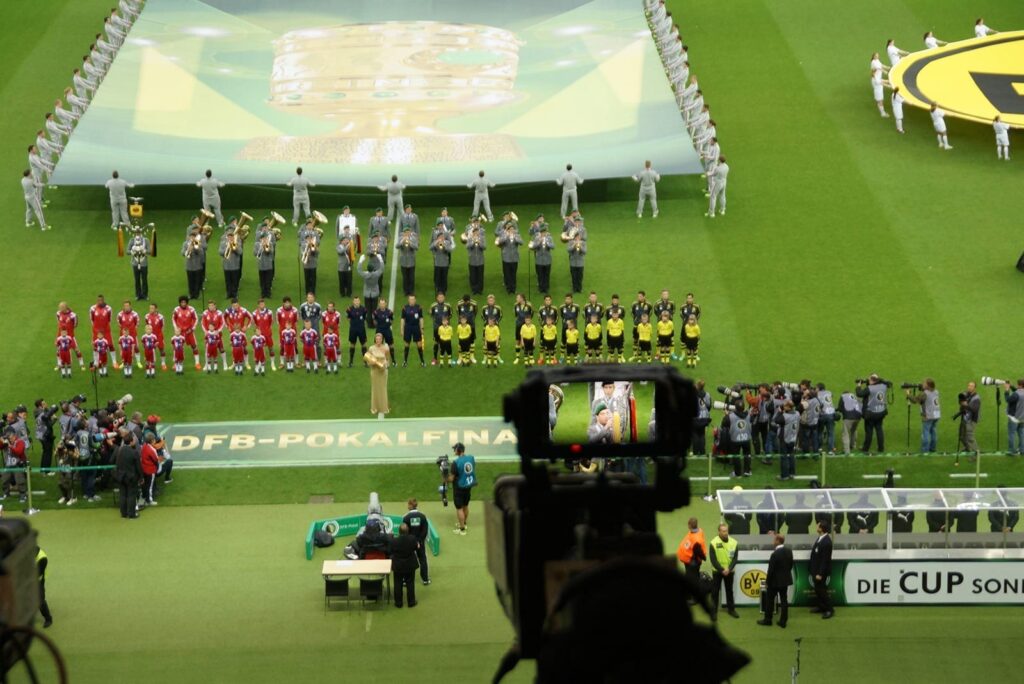
The future of movie, sports and concert broadcasting lies in 4K definition, which will bring cinema quality TV viewing into people’s homes.
4K Ultra HD has four times as many pixels as today’s Full HD. And thanks to the new HEVC video compression standard, broadcasters can now transmit live video in the 4K digital cinema standard. From September 12 to 16, 2014, Fraunhofer researchers will be presenting latest hardware and software for high efficiency video encoding and decoding at the International Broadcasting Convention IBC in Amsterdam, Netherlands (Hall 8, Booth B80).
A few months ago the broadcaster Sky achieved a world first by transmitting a Bundesliga scoccer game live in 4K definition – the current digital cinema standard. With its 3840 x 2160 resolution, 4K provides four times as many pixels as today’s Full HD TV resolution. Higher resolutions inevitably creates more than four times the data volumes of standard HD, so the broadcaster used the new HEVC video compression standard to transmit the huge amount of data. HEVC, short for High Efficiency Video Coding, was developed by major electronics manufacturers together with researchers from the Fraunhofer Institute for Telecommunications, Heinrich-Hertz-Institut, HHI. The key advantage of HEVC is that it requires only half the bitrate of its predecessor H.264 to provide the same picture quality – allowing it to transmit twice as much data on the same channel. This means that HEVC is practically made for the ultra-high definition of 4K television.
Live coding of 4K images with HEVC
The video compression technique was used for the game between FC Bayern Munich and SV Werder Bremen held in the Allianz Arena on April 26, 2014. The live coding of the 4K camera images from the stadium enabled the successful application of the technique developed by the HHI researchers together with their colleagues at Rohde & Schwarz. The HHI´s software and hardware solutions convert the camera images into a coded HEVC bitstream, which is then transmitted to televisions via satellite. Benjamin Bross, who heads up the HEVC project at the HHI, explains why this process is so special: “For the first time, we were able to encode 4K recordings live.”
The Latest on: Display resolution
[google_news title=”” keyword=”display resolution” num_posts=”10″ blurb_length=”0″ show_thumb=”left”]
via Google News
The Latest on: Display resolution
- Hilliard City Council criticized after passing resolution denouncing Israel on Passoveron April 27, 2024 at 8:22 pm
A call for peace has turned into a call for resignation in a central Ohio city council. Leaders with the Columbus Jewish Community Relations Council are calling for the Hilliard City Council President ...
- Nintendo Switch 2 Leak Reveals Screen Resolutionon April 27, 2024 at 7:02 am
These rumours come from third-party controller manufacturer, Mobapad. Nintendo's next console, commonly referred to as the Switch ...
- Innocn launches 27D1Q monitor boasting 2K 100Hz panel for $98on April 26, 2024 at 5:00 pm
Let’s check out its key specs. The monitor boasts an IPS LCD display with a resolution of 2560×1440 and a 100Hz refresh rate. The panel comes with 300 nits brightness and a 178° viewing angle. The ...
- LG's 32-inch gaming OLED monitor with 480Hz refresh rate is imminent, with pre-orders live nowon April 26, 2024 at 12:30 pm
LG 32GS95UE can run 480Hz at 1080p, or switch to 240Hz while bumping the resolution to 4K, giving you options - and a 0.03ms response time.
- The Kobo Libra Colour is the color screen e-reader we’ve been waiting foron April 26, 2024 at 6:48 am
The Kobo Libra Colour brings color to the black and white world of e-readers, so we had to test it to see if it’s right for you.
- Samsung’s crazy 57-inch curved 4K monitor is $700 off todayon April 26, 2024 at 6:18 am
The 57-inch Samsung Odyssey Neo G9 curved gaming monitor, which offers dual 4K Ultra HD resolution, is down to $1,800 from Samsung following a $700 discount.
- European Parliament adopts resolution condemning Georgia's foreign agents lawon April 25, 2024 at 9:02 am
EU officials have previously strongly suggested that the law's passage would hurt Georgia's chances of becoming a member of the EU.
- Save $1300 Off This Dell XPS 17 Slim Laptop with Better Than 4K Resolutionon April 25, 2024 at 8:35 am
You don't see this laptop on sale very often. Today Dell is offering this Dell XPS 17 slim laptop, featuring an a greater than 4K resolution display, Intel Core i9 processor, and GeForce RTX 4080 ...
- China: Researchers build high-resolution lidar with lowest-power laseron April 25, 2024 at 7:00 am
To validate the new system, the researchers conducted daytime tests onboard a small airplane in Yiwu City, Zhejiang Province.
- Swave Photonics debuts Holographic eXtended Reality display with tiny-pixel technologyon April 25, 2024 at 6:00 am
Holographic display startup Swave Photonics today announced the development of what is claimed to be the world’s first 3D holographic display technology for compact extended reality form factors such ...
via Bing News










